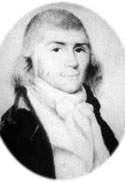Thomas Currie (settler) on:
[Wikipedia]
[Google]
[Amazon]
Islands of Refreshment was the name given to 
Tristan da Cunha
Tristan da Cunha (), colloquially Tristan, is a remote group of volcanic islands in the South Atlantic Ocean. It is the most remote inhabited archipelago in the world, lying approximately from Cape Town in South Africa, from Saint Helena a ...
by its self-proclaimed ruler, Jonathan Lambert, in 1811.

History
In the early 19th century American whalers frequented the neighboring waters and, on December 27, 1810, the Boston ship ''Baltic
Baltic may refer to:
Peoples and languages
* Baltic languages, a subfamily of Indo-European languages, including Lithuanian, Latvian and extinct Old Prussian
*Balts (or Baltic peoples), ethnic groups speaking the Baltic languages and/or originati ...
'' put ashore an American named Jonathan Lambert "late of Salem, mariner and citizen thereof" along with one Thomas Currie or Tomasso Corri in his employ, and a third man named Williams. These three were the first permanent inhabitants of Tristan, and they were soon joined by a fourth, Andrew Millet.
Lambert declared himself sovereign and sole possessor of the island group "grounding my right and claim on the rational and sure ground of absolute occupancy". He renamed the main island "Island of Refreshment", Inaccessible Island
Inaccessible Island is a volcanic island located in the South Atlantic Ocean, south-west of Tristan da Cunha. Its highest point, Cairn Peak, reaches , and the island is in area. The volcano was last active six million years ago and is curren ...
"Pintard Island" and Nightingale Island
Nightingale Island is an active volcanic island in the South Atlantic Ocean, in area, part of the Tristan da Cunha group of islands. They are administered by the United Kingdom as part of the overseas territory of Saint Helena, Ascension and Tri ...
"Lovel Island". Five months after arriving, Lambert, Williams and Millet drowned while fishing on May 17, 1812. Currie was joined, however, by two other men, and the three busied themselves growing vegetables, wheat and oats, and breeding pigs.
During the War of 1812
The War of 1812 (18 June 1812 – 17 February 1815) was fought by the United States, United States of America and its Indigenous peoples of the Americas, indigenous allies against the United Kingdom of Great Britain and Ireland, United Kingdom ...
, the islands were used as a base by American cruisers sent to prey on British merchant ships. This and other considerations urged by Lord Charles Henry Somerset
Lord Charles Henry Somerset PC (12 December 1767 – 18 February 1831), born in Badminton, England, was a British soldier, politician and colonial administrator.Charles Mosley, editor. Burke's Peerage and Baronetage, 106th edition, 2 volu ...
, then-governor of Cape Colony
The Cape Colony ( nl, Kaapkolonie), also known as the Cape of Good Hope, was a British colony in present-day South Africa named after the Cape of Good Hope, which existed from 1795 to 1802, and again from 1806 to 1910, when it united with t ...
in South Africa, led the British government to annex the islands as dependencies of the Cape Colony. The formal proclamation of annexation was made on August 14, 1816, partly as a measure to ensure the French could not use the islands as a base for a rescue
Rescue comprises responsive operations that usually involve the saving of life, or the urgent treatment of injuries after an accident or a dangerous situation.
Tools used might include search and rescue dogs, mounted search and rescue ...
operation to free the deposed Napoleon I of France from his prison on Saint Helena.
References
History of Tristan da Cunha Former unrecognized countries Former monarchies of Africa Island countries Micronations States and territories established in 1811 States and territories disestablished in 1816 Former countries in Africa Self-proclaimed monarchy {{TristandaCunha-stub fr:Tristan da Cunha (archipel)